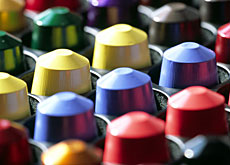giving old coffee a modern flavour

Nespresso, Nescafé's instant coffee powder concept, has added a big Swiss element to coffee consumption since it was launched in 1988.
Even though Nespresso is entirely Swiss-made, the world’s largest food company has revolutionised the modern coffee market while going global at the same time.
When Novartis sold “Ovaltine” in 2002, market experts expected Nestlé to bid for it. But it was the British food company ABF who finally took over the famous Swiss lifestyle brand.
Why was Nestlé not interested in buying Ovaltine? Even though the Swiss brand has some attractive features, experts think that the days of the Swiss national skiing team’s drink are over. The Swiss lifestyle has changed and products like Nestlé’s Nespresso are now more fashionable.
Nespresso is an attempt by Nestlé to turn the Italian coffee culture into a neat Swiss concept.
It was first introduced in 1988 and Nespresso boss, Gerhard
Berssenbrügge, is expecting a turnover of more than SFr1 billion ($810 million) in 2007.
Ovaltine, which was launched in 1904, was worth SFr400 million when ABF bought it over four years ago.
Top ten
By 2005 Nestlé’s capsule system had managed to get into the top ten of domestic brands and its popularity is still rising.
Even though Nespresso has not yet achieved the same kudos as Ovaltine, it has everything it takes to become a real “Swiss brand”: it is neat, expensive, luxurious, innovative, entirely Swiss made and popular abroad.
Nespresso is clearly more influenced by the rules of global marketing than other products: it is a premium lifestyle product, which thanks to its single portion system shows a great deal of individualism.
Even though it can only be brewed in special coffee machines, Nestlé has given other companies the green light to manufacture machines that fit the capsules.
Part of Nespresso’s success story can be attributed to the fact that the name reminds many Swiss coffee consumers of “Nescafé”, which, according to the Brand Management Company Interbrand Zintzmeyer & Lux, is currently worth SFr15.2 billion. At this value Nescafe positions itself before Switzerland’s biggest bank, UBS.
While classic coffee machines are still quite expensive, Nespresso machines are sold at a reasonable price. One of its advantages is that the practical capsule system requires hardly any cleaning.
Recyclable
Environmentalists initially criticised the system as they argued the aluminium capsules generated too much waste. Since then the capsules have been made recyclable.
The individual portions are economical and easy to use, but the price of a cup of coffee is quite steep. While you might spend around ten cents on a cup of homebrewed conventional coffee, a cup of Nespresso costs about five
times more. Nestlé’s concept of expensive individual portions is similar to the expensive system of colour cartridges for cheap printers.
Cartridges for cheap printers are normally incompatible with other printers.
For this reason Nespresso’s capsules do not fit into coffee machines by other manufacturers, which have since come up with similar systems.
Nestlé has allowed other manufacturers, such as Turmix, Jura, Miele and Siemens, to produce Nespresso machines, allowing Nespresso capsules to cross borders easily. At the end of 2005 Nespresso was available in 35 countries.
Nespresso is trying to create its own community similar to what Ovaltine was in the skiing and sporting arena in the 1930s.
Nestlé’s marketing managers have come up with top-notch terminology for their goods. The capsules are called “Gran Crus” and Nespresso shops are dubbed “boutiques”,
where customers can seek advice or find out more about Nespresso.
With Nespresso, Nestlé has created a typical Swiss product that offers not only quality coffee but a well-structured and high-quality concept.
swissinfo, Alexander Künzle
Nespresso is available in 35 countries.
Eastern Europe, Asia and South America are currently being developed as new markets.
The size of the capsules has never changed but other manufacturers are allowed to produce machines that fit the capsules.
Nespresso capsules are not compatible with coffee machines of other manufacturers.
The capsules are not sold to wholesalers.
Nespresso items are only sold in so-called boutiques and via the internet.
Nespresso was launched in 1988 and has enjoyed an annual growth of about 25 per cent.
In 2004, the company sold around 1.3 billion capsules.
By 2007, the company wants to achieve a turnover of SFr1 billion, and SFr2 billion by the end of the decade.
Nespresso employs over 1,300 people worldwide.

In compliance with the JTI standards
More: SWI swissinfo.ch certified by the Journalism Trust Initiative








You can find an overview of ongoing debates with our journalists here . Please join us!
If you want to start a conversation about a topic raised in this article or want to report factual errors, email us at english@swissinfo.ch.